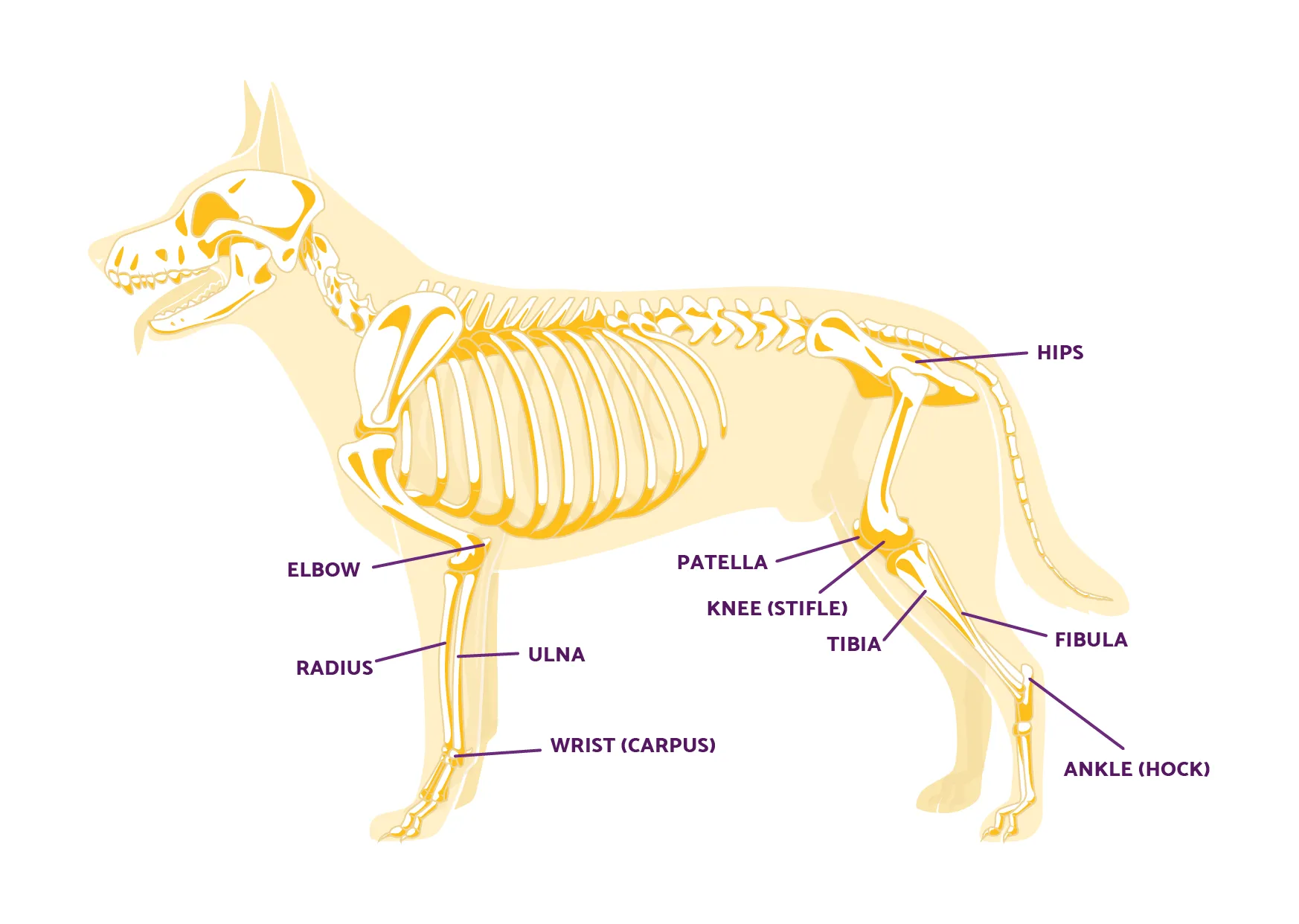The cranial cruciate ligament (CCL), often referred to as the ACL in humans, is a critical component of a dog’s knee joint. Tears to this ligament are a common and often painful injury for canine companions. While the thought of a cruciate ligament healing itself in dogs is appealing, understanding the reality of this injury and its treatment is paramount for pet owners. This article delves into the nature of CCL tears, explores the possibility of natural healing, and outlines the various treatment avenues available, from conservative management to surgical interventions, focusing on providing comprehensive and accurate information for dog owners.
Understanding Canine Cranial Cruciate Ligament Tears
In dogs, the ligament analogous to the human ACL is the cranial cruciate ligament (CCL). This vital connective tissue runs diagonally through the knee joint, playing a crucial role in stabilizing the knee by preventing the tibia (shin bone) from sliding forward relative to the femur (thigh bone) and limiting excessive rotation. A tear in the CCL can range from a partial rip to a complete rupture, leading to significant pain, instability, and lameness.
The injury in dogs often differs from that in humans. While human ACL tears are frequently acute, resulting from sudden, forceful trauma during sports, CCL tears in dogs can develop gradually over time. This progressive damage is often attributed to repetitive stress from everyday activities, exacerbated by factors such as obesity, lack of consistent exercise, overexertion, and the natural aging process.
 Diagram illustrating the anatomy of a dog's knee joint, highlighting the cranial cruciate ligament.
Diagram illustrating the anatomy of a dog's knee joint, highlighting the cranial cruciate ligament.
Recognizing the Symptoms of a Torn CCL
Identifying the signs of a CCL tear is crucial for prompt veterinary attention. The severity of the tear will dictate the symptoms your dog exhibits, but common indicators include:
- Limping or Lameness: This is the most prevalent symptom. Your dog will likely favor the injured leg, holding it up or bearing less weight on it.
- Difficulty Rising or Sitting: The instability and pain in the knee can make these simple movements challenging.
- Abnormal Posture: Dogs may adopt unusual sitting or standing positions to alleviate pressure on the affected limb.
- Swelling and Inflammation: The knee joint may appear visibly swollen or feel warm to the touch.
- Clicking Sound: In some cases, a clicking or popping sound may be heard when the knee is manipulated.
It’s important to note that a CCL tear in one knee significantly increases the risk of injury to the other knee. This is because the compensatory strain placed on the healthy leg can lead to damage over time, with approximately 60% of dogs experiencing a tear in the opposite knee.
Can a Cruciate Ligament Heal Itself in Dogs?
The short answer is, no, a torn cranial cruciate ligament (CCL) in dogs does not heal itself in a functional way. Unlike some other tissues in the body that have a robust capacity for self-repair, the CCL has a very poor blood supply, which significantly limits its ability to regenerate.
While a dog might experience some temporary improvement or a reduction in inflammation, the torn ligament fibers will not reattach or fully restore their original strength and function. This lack of self-healing means that a torn CCL will typically result in chronic instability and progressive arthritis in the knee joint if left untreated.
The Role of Conservative Management and Surgery Alternatives
Given that the ligament itself won’t heal, the focus shifts to managing the instability and pain. For mild partial tears, or in dogs where surgery is not an option, conservative management can be explored. This approach aims to support the joint and minimize further damage, rather than achieving a complete biological repair of the ligament.
Conservative management strategies include:
- Rest and Activity Restriction: Limiting strenuous activities, jumping, and running is crucial to prevent further injury and allow some scar tissue to form, offering minimal stability.
- Weight Management: Excess weight puts significant stress on the knee joint. Maintaining a healthy weight is vital for reducing strain and promoting healing.
- Anti-inflammatory Medications: Veterinarians may prescribe non-steroidal anti-inflammatory drugs (NSAIDs) to manage pain and reduce inflammation.
- Physical Therapy and Rehabilitation: Gentle exercises, such as controlled leash walks and swimming, can help maintain muscle mass around the knee, which provides some support. Hydrotherapy can be particularly beneficial.
- Nutritional Supplements: Supplements like glucosamine, chondroitin, omega-3 fatty acids (fish oil), and turmeric are often recommended to support joint health and reduce inflammation. These do not heal the ligament but can help manage arthritis symptoms.
- Orthopedic Dog Braces: These braces are designed to stabilize the knee joint by limiting excessive flexion and extension. They can help reduce pain and provide support during the healing process, allowing scar tissue to form over the torn area. While a brace doesn’t heal the ligament, it can significantly improve comfort and function.
 A dog wearing an orthopedic knee brace designed to support a torn CCL.
A dog wearing an orthopedic knee brace designed to support a torn CCL.

It’s important to emphasize that conservative treatments are often best suited for dogs with very mild partial tears, older dogs with low activity levels, or when surgery is contraindicated due to health concerns. The success of these methods varies greatly depending on the individual dog and the severity of the tear.
Surgical Interventions for CCL Tears
For most dogs with a confirmed CCL tear, surgery is the most effective treatment to restore knee stability and significantly reduce the risk of progressive arthritis. Surgical options aim to compensate for the lack of the functional CCL, allowing the dog to regain normal use of its leg. The primary surgical techniques include:
Lateral Suture Technique (Extracapsular Repair): This is a common and less invasive procedure where a synthetic suture material is placed outside the joint capsule to mimic the function of the torn ligament. It’s generally less expensive but may be more prone to failure in larger, active dogs compared to other methods.
Tibial Plateau Leveling Osteotomy (TPLO): This advanced surgical technique reshapes the top of the tibia (tibial plateau) to create a more level surface. This biomechanical alteration neutralizes the forces that cause the tibia to slide forward, effectively eliminating the need for the intact CCL. TPLO is highly effective and offers excellent long-term outcomes for many dogs.
Tibial Tuberosity Advancement (TTA): Similar to TPLO, TTA also aims to change the knee’s biomechanics to prevent forward tibial movement. In this procedure, the front part of the tibia is cut and advanced forward, with a spacer inserted to maintain the altered angle. A metal plate secures the bone in place. TTA is also a successful method for stabilizing the knee.
 A veterinary surgeon performing orthopedic surgery on a dog's knee.
A veterinary surgeon performing orthopedic surgery on a dog's knee.
The choice of surgical procedure depends on several factors, including the dog’s size, breed, age, activity level, the surgeon’s expertise, and the cost. Your veterinarian will discuss these options thoroughly to determine the best course of action for your individual dog.
Costs Associated with Surgery
The financial investment for CCL surgery can vary significantly. The lateral suture technique typically ranges from $1,100 to $2,500. TPLO surgery generally costs between $3,000 and $6,000, while TTA procedures fall within the range of $3,500 to $4,500. These figures are estimates and can vary based on geographic location, veterinary clinic, and the complexity of the case. It’s essential to factor in the costs of pre-operative diagnostics, anesthesia, surgery, post-operative care, pain medication, and rehabilitation when budgeting for CCL treatment.
Post-Operative Care and Recovery
Regardless of the treatment chosen, dedicated post-operative care is crucial for a successful recovery. This typically involves a period of strict rest and confinement for 8 to 12 weeks, followed by a gradual reintroduction of exercise and physical therapy. Close monitoring for signs of infection, excessive swelling, or discomfort is essential. Your veterinarian will provide specific post-operative instructions tailored to your dog’s needs.
Consulting Your Veterinarian
The most critical step in addressing a suspected CCL tear is to consult a licensed veterinarian. They can accurately diagnose the injury through physical examination and, if necessary, imaging such as X-rays. Based on the diagnosis, the veterinarian will discuss all available treatment options, taking into account your dog’s specific condition, age, breed, and your financial considerations.
While the idea of a cruciate ligament healing itself in dogs is a hopeful one, it is not a biological reality. Understanding the limitations of natural healing and the various treatment modalities available will empower you to make informed decisions for your canine companion’s well-being and help them return to a pain-free, active life.
